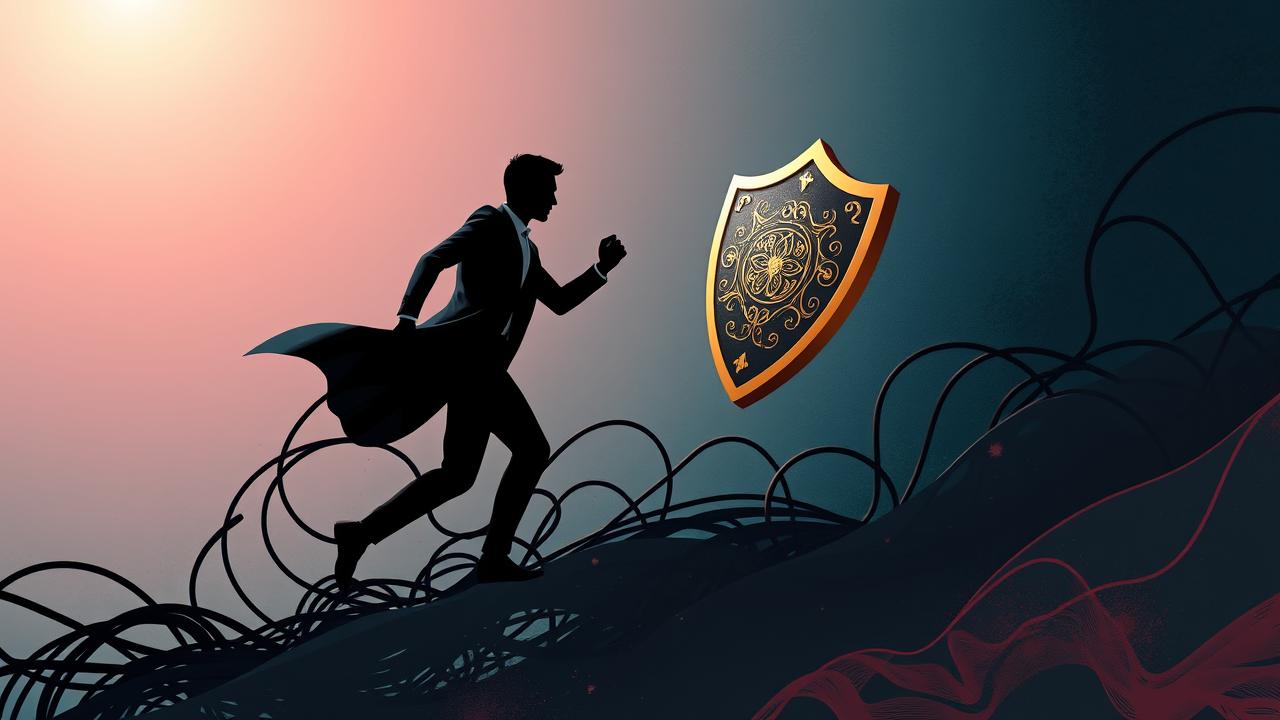When the credit card statement hits your inbox, is like a gut punch!. Especially when the number staring back feels less like a balance and more like an anchor weighing you down. You’re absolutely not alone in this – Americans are currently juggling over a trillion dollars in credit card debt, with average balances for households carrying debt often soaring past $10,000.
It’s easy to feel powerless, maybe even a little ashamed. But here’s the truth buried under all that stress: you have more options than you might think. Forget the expensive settlement companies promising miracle cures for a hefty fee. Learning how to negotiate credit card debt settlement yourself can put you back in control and potentially save you a significant amount of money. It takes grit, preparation, and a willingness to advocate for yourself, but it’s absolutely possible.
This isn’t about magic wands; it’s about practical steps and realistic expectations for dealing directly with your creditors. Let’s walk through it together.
Click here to see what’s covered:
- Why Even Try Negotiating Yourself? (Hint: You Can!)
- Step 1: Get Crystal Clear on Your Financial Picture
- Step 2: Prepare for Battle (The Right Way)
- Step 3: Making the Call – Your Negotiation Game Plan
- Step 4: Seal the Deal (And Get It In Writing!)
- Step 5: After the Settlement – Staying on Track
- Common Traps to Avoid When Settling Debt Yourself
- What If Settlement Isn’t Right? Other Paths Forward
- Okay, What Now? Your First Small Step
- Still Have Questions? Quick Answers Here
Why Even Try Negotiating Yourself? (Hint: You Can!)
Let’s be real: calling a creditor isn’t exactly a fun Saturday afternoon. So why go through the trouble yourself instead of hiring a company?
- Save Money: Debt settlement companies charge fees, sometimes a significant percentage of the debt you settle or the amount saved. Doing it yourself means every dollar saved stays in your pocket. In fact, some reports suggest DIY negotiators often save more overall because there are no fees.
- Maintain Control: You’re in the driver’s seat. You decide what you can realistically offer and what agreement terms work for your situation, not a third party’s commission structure.
- Learn Valuable Skills: Successfully navigating this process builds confidence and financial literacy that will serve you well long after the debt is gone. Think of it like financial self-defense training.
- Potentially Faster Results: You can move at your own pace, without waiting on a company’s processes or caseload.
It’s not easy street, but the potential benefits of taking the reins are huge. Think about someone like ‘Maria’ – after an unexpected job loss piled debt onto her existing cards, the thought of calling felt terrifying. But paying high fees to someone else felt worse. She decided the potential savings and control were worth facing the fear.
Step 1: Get Crystal Clear on Your Financial Picture
Before you even think about picking up the phone, you need to know exactly where you stand. Flying blind is a recipe for a bad deal. This means getting brutally honest with yourself about the numbers.
- List ALL Your Debts: Credit cards, medical bills, personal loans – everything. Note the creditor, the total amount owed, the interest rate, and how far behind (if at all) you are on payments.
- Calculate Your Income: What money is reliably coming in each month? Be realistic.
- Track Your Expenses: Where is your money actually going? Use bank statements, budgeting apps, or good old pen and paper. Identify needs vs. wants.
- Determine What You Can Realistically Offer: Based on your income and essential expenses, what amount could you genuinely afford to pay towards a settlement? Be prepared to offer this as either a lump sum (usually preferred by creditors) or structured payments over a short period. Having $0 left over each month isn’t a negotiation strategy; it’s a sign you might need different help (more on that later).
This step isn’t fun, but it’s foundational. Knowing these details gives you leverage and prevents you from agreeing to something you ultimately can’t afford. Maria started this process feeling overwhelmed, just staring at a pile of bills. Her first step? Simply listing them out on one sheet of paper. Small action, big clarity.
Step 2: Prepare for Battle (The Right Way)
Okay, “battle” might sound intense, but preparation is key. Creditors handle these calls all day; you need to be ready to present your case clearly and calmly.
- Gather Your Documents: Have your account statements, your budget calculations, and any proof of hardship readily available. This could include layoff notices, medical bills, proof of reduced income, etc.
- Understand Your Hardship (and how to explain it): Why are you unable to pay the full amount? Be honest, concise, and focus on the facts. Job loss, illness, divorce, reduced income – these are common reasons. Avoid blaming the creditor; focus on your circumstances. Prepare a brief explanation (your “hardship story”).
- Know Your Rights: Understand debt collection laws. The Consumer Financial Protection Bureau (CFPB) offers clear guidance on what collectors can and cannot do. Knowing your rights prevents intimidation tactics from working.
- Set Realistic Goals: Research typical settlement percentages (often 30-60% of the balance, but it varies wildly). Don’t expect 90% forgiveness. Decide on your ideal settlement amount/percentage and your absolute maximum walk-away point before you call.
- Script It Out (Loosely): You don’t need a word-for-word script, but jotting down key points helps: your name, account number, brief hardship explanation, your settlement offer, and key questions to ask (like ensuring the settlement resolves the entire debt). Practice saying it out loud. Maria practiced her points with a friend, which helped calm her nerves before the real call.
“Lenders are taking more of a conservative position… [and] looking at alternative data points such as income, cash flow and employment…” – This insight, paraphrased from Rakesh Patel at Experian, highlights why your documented financial situation and hardship story are so crucial. They need context beyond just the missed payments.
Step 3: Making the Call – Your Negotiation Game Plan
Deep breath. This is where the rubber meets the road. Remember, the person on the other end is just doing their job. Stay calm, polite, but firm.
- Get the Right Department: Call the creditor’s main customer service line and ask for the department that handles debt settlements or hardship programs (sometimes called “Loss Mitigation” or similar). If your debt is already with a collection agency, you’ll negotiate with them directly.
- Identify Yourself & State Your Purpose Clearly: “Hello, my name is [Your Name], and my account number is [Account #]. I’m calling because I’m experiencing financial hardship and I’d like to discuss settling this debt.”
- Explain Your Hardship Briefly: Stick to your prepared points. Be factual and concise.
- Make Your Initial Offer: Start low, but not ridiculously low (unless your situation is dire). “Based on my current financial situation, I can offer a lump sum of $[Your Offer Amount] to settle this debt in full.”
- Listen to Their Response & Handle Pushback: They will likely counteroffer or say no initially. Don’t get flustered.
- If they counter: Evaluate if it fits within your pre-determined maximum. You can counter back: “I appreciate that offer, but given my circumstances, the best I can realistically manage is $[Your Counter Offer].”
- If they say no flat out: Ask why. Maybe they need more documentation? Maybe you need to speak to a supervisor? Politely reiterate your situation and your desire to resolve this. Sometimes ending the call politely and trying again later (perhaps end of month/quarter) can yield different results.
- Be Persistent (Politely): Negotiation often takes multiple calls. Don’t be discouraged by an initial “no.” Think about ‘Elena’, the freelancer we mentioned earlier – her first attempt got rejected flat out. It took refining her approach and calling back before she started making progress. Persistence is one of the key credit card debt settlement negotiation tactics.
- Take Notes: Document everything – date, time, name of the representative you spoke with, offers made, agreements reached.
Timing Tip: Some sources suggest creditors might be more motivated to settle near the end of a month or financial quarter to meet goals. It’s not guaranteed, but worth considering.
Step 4: Seal the Deal (And Get It In Writing!)
Congratulations! You’ve reached a verbal agreement. But do not send any money until you have the settlement agreement in writing.
- Request Written Confirmation: Ask the representative to mail or email you a formal settlement letter.
- Review the Letter Carefully: Ensure it includes:
- Your name and account number.
- The total amount of the debt being settled.
- The agreed-upon settlement amount.
- The payment terms (lump sum due date or payment schedule).
- A statement that this payment will satisfy the debt in full and that the creditor will report it to credit bureaus as “settled in full,” “paid settled,” or similar (avoiding terms like “charged off as bad debt” if possible, though “settled for less than full balance” is common).
- Confirmation that they will cease collection efforts upon payment.
- If Anything is Unclear or Incorrect: Call back and get it corrected before sending payment.
This written agreement is your proof. Without it, you risk the creditor coming back later saying you still owe the remaining balance. This is non-negotiable.
Step 5: After the Settlement – Staying on Track
You’ve done the hard part, but there are a few crucial follow-up steps:
- Make the Payment(s) On Time: Whether it’s a lump sum or scheduled payments, adhere strictly to the agreement. Keep proof of payment (canceled check, bank statement).
- Monitor Your Credit Report: After about 30-60 days, check your credit reports (you can get free ones annually) to ensure the account is reported correctly according to your agreement (e.g., “Settled for less than full amount,” ideally with a $0 balance). Dispute any errors immediately. Find information on checking reports at sites like Experian.
- Understand Tax Implications: Forgiven debt over $600 is generally considered taxable income by the IRS. You might receive a Form 1099-C (Cancellation of Debt). However, if you were insolvent (your liabilities exceeded your assets) at the time of settlement, you might not owe taxes on it. Consult a tax professional – this is important!
- Rebuild Your Finances: Use this opportunity to build an emergency fund, stick to a budget, and use credit responsibly moving forward.
Settling debt can temporarily lower your credit score because you didn’t pay the full amount. However, it’s often less damaging than letting the debt go to collections or declaring bankruptcy, and your score can recover over time with responsible financial habits.
Common Traps to Avoid When Settling Debt Yourself
Navigating the steps to settle credit card debt on your own is empowering, but watch out for these potential stumbles:
- Sending Money Without a Written Agreement: We said it before, we’ll say it again. HUGE mistake.
- Agreeing to Payments You Can’t Afford: Be realistic about your budget. Over-promising leads back to square one.
- Ignoring the Tax Consequences: That 1099-C can be an unpleasant surprise if you’re not prepared. Factor potential taxes into your planning.
- Falling for Scams: Be wary of unsolicited calls offering debt relief. Legitimate creditors or collectors won’t typically pressure you into immediate payment over the phone without sending documentation first.
- Giving Up Too Easily: Negotiation takes patience. Don’t let one rejection derail your efforts. persistence, like ‘Marcus’ showed when tackling his family’s debt, is often required.
- Not Considering the Impact on Co-Signers: If someone co-signed on your debt, the settlement could potentially impact their credit too. Discuss this openly.
What If Settlement Isn’t Right? Other Paths Forward
DIY debt settlement isn’t the only option, and it’s not always the best one. If your hardship is temporary, you can’t afford a lump sum, or creditors won’t budge, consider these:
- Debt Management Plan (DMP): Offered by non-profit credit counseling agencies, a DMP consolidates your monthly payments into one, often with lower interest rates negotiated by the agency. You pay the full debt back over 3-5 years. This is generally better for your credit score than settlement. Reputable agencies can be found through the National Foundation for Credit Counseling (NFCC).
- Balance Transfer Card: If you have good enough credit, transferring high-interest debt to a card with a 0% introductory APR can save you money on interest and help you pay down principal faster. Be mindful of transfer fees and the APR after the intro period ends.
- Personal Loan for Debt Consolidation: Similar to a balance transfer, but uses a fixed-rate loan to pay off cards. Can simplify payments but requires good credit for favorable rates.
- Bankruptcy (Chapter 7 or 13): A last resort, but sometimes the necessary path for overwhelming debt. It has significant long-term credit implications but offers a legal fresh start. Consult a bankruptcy attorney to understand if this is right for you.
Choosing the right path depends entirely on your unique financial situation, debt level, and goals.
Okay, What Now? Your First Small Step
Reading this guide is a fantastic first step – seriously, acknowledging the problem and exploring solutions takes courage. Feeling overwhelmed by all the info? That’s totally normal.
Don’t try to tackle everything at once. Your next step doesn’t have to be huge. Maybe tonight, it’s just gathering your most recent credit card statements in one place. Maybe tomorrow, it’s calculating your total debt amount. Or perhaps it’s exploring resources on a trusted site like NerdWallet to see different perspectives.
Pick ONE small, manageable action you can take in the next 24 hours. Progress, not perfection. You learned how to negotiate credit card debt settlement yourself – now it’s about taking that knowledge and putting one foot in front of the other. You can do this.
Still Have Questions? Quick Answers Here
Common questions about negotiating credit card debt yourself:
- How much can I realistically save? While it varies greatly, settlements often range from 30% to 60% of the original balance owed. Some achieve more, some less. It depends on the creditor, the age of the debt, your hardship, and your negotiation skills.
- Will this wreck my credit score? Settling debt for less than the full amount will negatively impact your credit score, typically shown as “settled for less than full balance.” However, it’s usually considered less damaging than ongoing missed payments, charge-offs, or bankruptcy. Your score can recover over time with good financial behavior post-settlement.
- How long does this whole process take? Negotiating and finalizing a settlement for one account might take a few weeks to several months. Settling multiple debts can take longer, potentially 1-3 years, depending on how much you can offer and how many creditors are involved.
- What if the creditor just refuses to negotiate? It happens. Not all creditors are willing, or willing initially. You can try calling back later, politely ask to speak to a supervisor, or reiterate your hardship. If they remain firm, you may need to shift focus to other debts or consider alternatives like a DMP or, in severe cases, bankruptcy counseling.
- Do I really have to worry about taxes? Yes. The IRS generally views forgiven debt (over $600) as taxable income. Look out for a 1099-C form. However, the insolvency exclusion might exempt you. It’s highly recommended to consult with a qualified tax advisor to understand your specific situation.
- Is it better to offer a lump sum or payments? Creditors strongly prefer lump-sum settlements because it’s guaranteed money upfront. You’ll likely get a better deal (a lower settlement percentage) if you can offer a lump sum. However, if that’s impossible, proposing a structured payment plan over a short period (e.g., 3-6 months) is the next best option.







